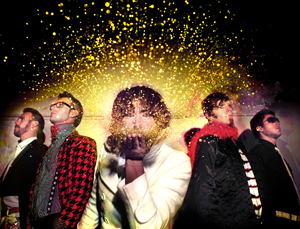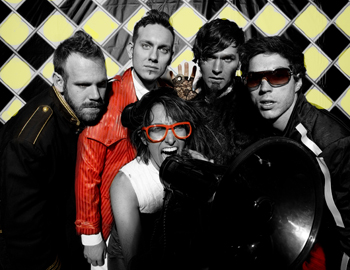On The Record: Ella Riot Make “Love Child” At Mission Sound
WILLIAMSBURG, BROOKLYN: Late last year, the Ann Arbor-based electro-rock band known as Ella Riot loaded into Mission Sound in Williamsburg for three days of tracking sessions with Oliver Straus. Wanting to capture some muscular rock rhythms to punch up their electronic production, Ella Riot tracked live band takes through Mission’s mighty Neve 8026.
“We wanted to do live tracking of the rhythm section to reflect the intensity of our live show,” says Ella Riot guitarist Bob Lester. “The last record we did was very multitrack, done piece by piece in our home studios. And it was a bit sterile and less in-your-face than what we do live.”
The band had been introduced to Straus over CMJ 2010 when they recorded a song at Mission with producers Patrick Ermlich and Eshy Gazit of NYC-based Modern Vintage Recordings.
At the time Ella Riot was still known as My Dear Disco, the name adopted when the band formed at the University of Michigan in 2007. As they conceived of their new record, Love Child, and planned to make a more “live” than electronic record to reflect an evolution in their sound, they finalized the name change and immediately made plans to return to NYC to record.
Still very much electro-based, Love Child adds a harder-edged pop-rock punch born out of a new production process that merges Ella Riot’s studio wizardry with live performances on drums, bass, guitars, keys and bagpipes. Coming into the studio with fully fleshed-out electronic versions of the tunes, they were able to infuse the productions with the energy and immediacy of these live performances.
“Mission Sound was a great studio for us because you get the space, the technology and Oliver’s ears,” says Lester. “He can hear what you’re going for, reach into the equipment and pull the nastiness right out of it. It was the first time we’ve been in a studio where without having to force the thing to sound how we wanted, it was just immediately way better than I could have imagined as soon as he pulled it up in the monitors.”
At Mission, it was all about capturing the moment. The band worked fast with Strauss as their guide. “Ollie’s sound is really built into the record in a lot of ways because we committed so many things to “tape” in those sessions that there’s really no undoing,” says keyboardist, bagpiper and vocalist Tyler Duncan. “And that was a really fun part of the process – allowing it have that spontaneity. So this recording is really a true snapshot of those three days.”
As such a beat-driven band, drums were a main focus of these recording sessions, and they are all psyched on the outcome. Says drummer Mike Shea: “The drums sound huge. I brought in my acrylic drum set – a giant bass drum and two floor toms – and it sounds super beefy and raw and the room compliments it really well.”
Back in Ann Arbor in his home studio, Duncan mixed the record, merging the live band tracks with their programmed sounds. The result is a modern-electro-pop collage primed as much for the dance floor as the rock venue as the synch license, punctuated by revving stutter edits, catchy pop synth riffs and rock drums and guitars of varying grit and heft.
Meanwhile all the lead vocals were recorded and edited by Ella Riot singer Michelle Chamuel and Duncan back in their bedroom studios in Logic. “I think of vocals the way an electric guitarist approaches their instrument,” says Chamuel. “With no effects, it can sound bland, but with effects, you get a whole different tone. Singing dry vs. effected is like the difference between a screaming guitar solo with distortion vs. without.
“For me, it’s so much easier to record while I can hear the effect – it’s like I’m synthesizing my voice to get the tone that will best express the emotional content. So I do it on my own rather than wasting the studio time having to ask for more reverb or feedback, etc.”
Lester, too, worked on his guitar parts and sounds before and after the tracking sessions at Mission. “We’re definitely a band that approaches music like electronic music producers,” says Lester. “But Tyler did the lion’s share of the mixing on this.” Duncan considers this role like that of a sound designer – “mixing is part of what this music is; it’s about how all the pieces work together.”
First off, he was able to replace all of the synth bass and programmed drums with live tracks. “Coming out of Mission, the drums sounded really rock and raw, and while I wanted to uphold that, I also wanted to bring the electronic vibe back into it in subtle ways, i.e. making the kick have a balanced relationship between the techno ideal (having it really thumping between 45 – 60Hz) but also have the slap of a rock drum. I wanted it to have that studio punch but still feel roomy and live.”
On the unique instrumental jam, “Clubbin’” a Uilleann bagpipe lead sits surprisingly naturally within the record’s electro-pop world. “The pipes were recorded live with the band at Mission Sound using a Foltec ribbon microphone,” says Duncan (the piper). “I find ribbon mics tend to smooth out the pipes in a nice way – they need some character and warmth to translate well in recording.
“And after the recording, I used anything and everything I could to fatten them up – PSP’s Vintage Warmer and Mix Saturator, URS’ A10EQ, Waves C4 multiband compressor and API compressor were used on all the pipes tracks.
I used Native Instruments Guitar Rig for the solo pipes with some intense distortion + delay + phaser effects that are blended in with the solo. Also used some iZotope Trash for some subtle saturation and vintage delays, and most of the parts are doubled in stereo to thicken it even more.”
Proof of concept, the aptly titled Love Child bears the signature traits of both the band’s live musicianship and electronic production savvy. And it wouldn’t exist in quite the same way without one or the other. The dancefloor anthem, “It Could Be,” for example, incorporates chopped up samples and synths and manipulated vocals — things that as Duncan points out “could never be done with an instrument.”
“There’s a lot of ear candy if you’re listening for it, but it’s all on a bed of this live band energy, the best takes of us playing together as a band in the studio. No time correction, no pitch correction – this is how we play.”
For more on Ella Riot visit the band website – http://www.dancethink.com – named for the genre they’ve coined to describe music. And download “Love Child” on iTunes.
Please note: When you buy products through links on this page, we may earn an affiliate commission.









